Click less.
Engineer more.
Python for Structural Engineers
Registration closes in:

Become a better engineer in 6 weeks
Get the most out of your computer. This course teaches Python, a straightforward programming language, for everyday structural engineering use.
- No programming experience required
- Learn to use AI as your engineering assistant
- Self paced - Take the time you need
- Integrate what you learn with the structural analysis software you already use - and Excel!
- Lifetime access*
- 100% Satisfaction Guarantee - 30 days refund!*
- Packed with tons of engineering examples
- * Terms and conditions apply
Faster
Free your time: Learn how to do batch calculations and build reusable calculation and finite element analysis postprocessing tools.
Better
Impress your clients: Create great looking outputs that are easy to understand and quality control. Even for people who are not familiar with code.
Automated
Don't repeat yourself: Set up workflows once, and adjust when needed.
Curriculum
Module 0
Day-to-Day Engineering Calculations
You’ll be guided through the basics of Python, from writing your first line of code to building digital tools that can handle most of your engineering calculations.
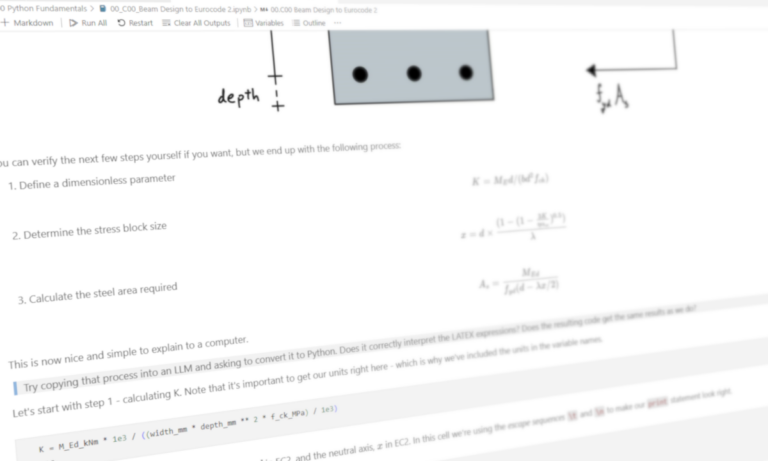
Module 1
Structural Analysis Plots – Better, Faster, Automated
We’ll dive into Matplotlib, a powerful plotting library in Python. We’ll explore examples like pile capacity plots, sensitivity analysis, and material quantity/cost plots. By the end, you’ll be able to create clear, professional plots for any engineering calculation.

Module 2
Excel on Steroids
We introduce the Pandas library to take spreadsheets to the next level while still using Excel. You’ll work with examples ranging from steel section catalogues to concrete test data to create useful tools that streamline your daily tasks.
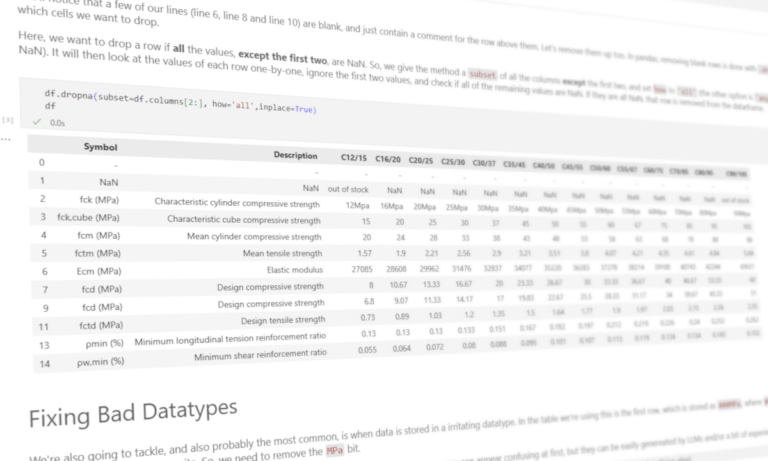
Module 3
Finite Element Models Through Text File Automation
Learn how to interact with files on your computer. You’ll read, modify, and create text files for finite element models. We’ll show you how to easily change a finite element model while keeping everything transparent and organized
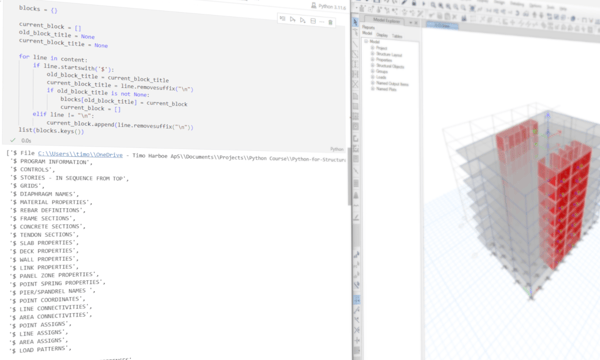
Module 4
Automate Finite Element Analysis Results Post-Processing
We return to Pandas to explore advanced features for creating templates to process the output from your finite element model. This module focuses on streamlining the process of extracting and analyzing finite element analysis results, helping you work faster and more efficiently.
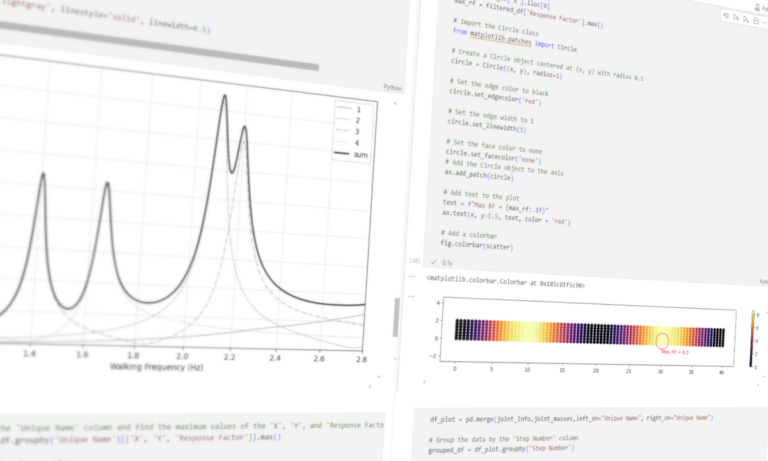
Meet the team

I’ve put together many of the lessons, exercises, and case studies for this course. I'm passionate about structural design and have worked on high-rise towers, lab spaces, and cultural venues.
I learnt Python during my degree at the University of Cambridge, and I have found Python to be an extremely powerful tool in nearly all aspects of structural engineering.
Now, I want to be part of helping our industry to use Python more effectively.

I'm skilled at breaking down complex ideas into engaging and enjoyable e-learning experiences. Using my analytical skills, I make tough concepts easy and fun for everyone. My approach is shaped by my Master’s degree in Education, ensuring effective and fun learning. I have supported Timo and Sam through various workshops to ensure the course meets e-learning best practices.
Amalie Langkjær E-Learning Specialist, MB & Partners
How you'll learn
- 100+ professionally edited short videos
- Interactive notebooks that cover everything in the course
- Multiple-choice quizzes to test your knowledge.
- Plenty of exercises to reinforce your learning.
- Larger projects to demonstrate how the skills you've learned can be applied to real-world problems
FAQ
Structural Engineers. The course is 100% centered around the daily tasks of a structural engineer. If you work with buildings, bridges, industrial structures or any other kind of load bearing structure this is for you.
Basic structural engineering knowledge is required, but no programming experience is needed. The first module covers Python fundamentals.
The course has 5 modules, each divided into submodules with interactive notebooks, exercise sheets, and video explanations. Complete exercises, review summaries, and pass a quiz to proceed. Some modules end with larger example use cases.
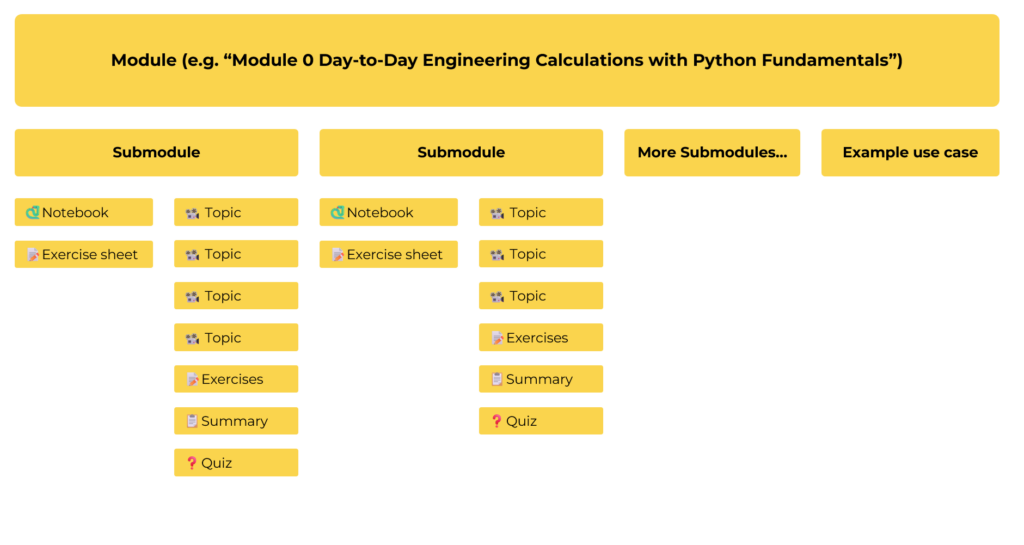
The course is designed for 6 weeks, with 4-6 hours per week. Move steadily through the first module to build a strong Python foundation; then, complete the remaining four modules at your own pace.
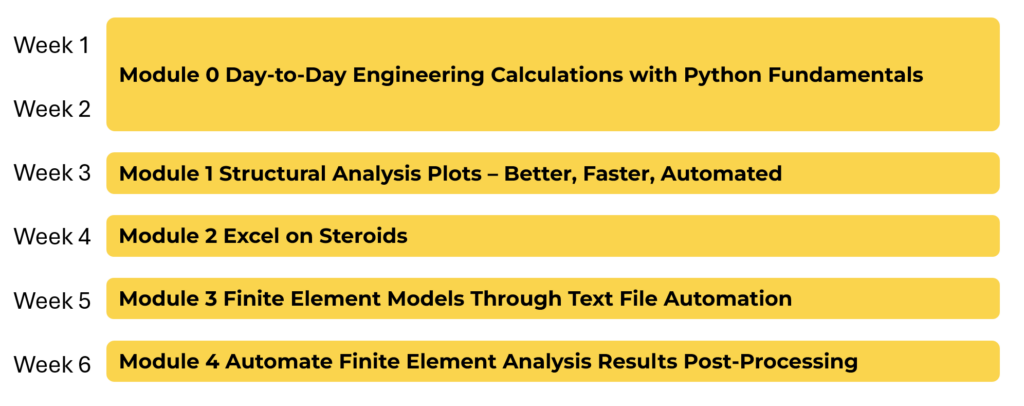
When you purchase access to the course, you receive:
- Interactive Notebooks: All course content, including comprehensive explanations and code, is provided in written format as interactive notebooks.
- Exercise Sheets & Quizzes: Practice your skills with exercise sheets and test your knowledge with quizzes.
- Video Lessons: Over 100 detailed, short, and professionally edited videos explaining the learning material.
- Lifetime Updates: If new material is added to the course, you’ll be notified and granted access.
- Community Forum: Join a forum where my partner and I are active, and engage in discussions with fellow students.
This is an on-demand, recorded course. Access it online, complete at your own pace, and enjoy lifetime access.
No, the course is designed to be independent of any specific software package.
A short registration window means more students are active at the same time, creating a more engaging community and it allows me to focus entirely on supporting current students.
No installation is required; the entire course can be completed online using Google Colab (free). You may choose to install Python locally as this will allow you to do everything that Python can do (also free).
Yes, enjoy a 30-day satisfaction guarantee with a full refund if you’re not satisfied. Terms and conditions apply.
Yes, and if you buy 7 licenses I'll give you an extra one for free.
Go to the checkout page for multiple licenses.
Also, feel free to contact me on timo@pythonforstructuralengineers.com for questions.
Please contact me on timo@pythonforstructuralengineers.com
We won’t be using Grasshopper in this course, but everything you learn can be applied directly in it. If you’re a Grasshopper user, learning Python is one of the best skills you can pick up!


I have experience from Rambøll High Rise and Bjarke Ingels Group. I use Python daily and found it to be a game changer for the quality and speed I deliver. I love the creative problem-solving aspect of structural engineering and want to enable more engineers to unlock the potential of their computers.
Timo Harboe Zollner Structural Engineer